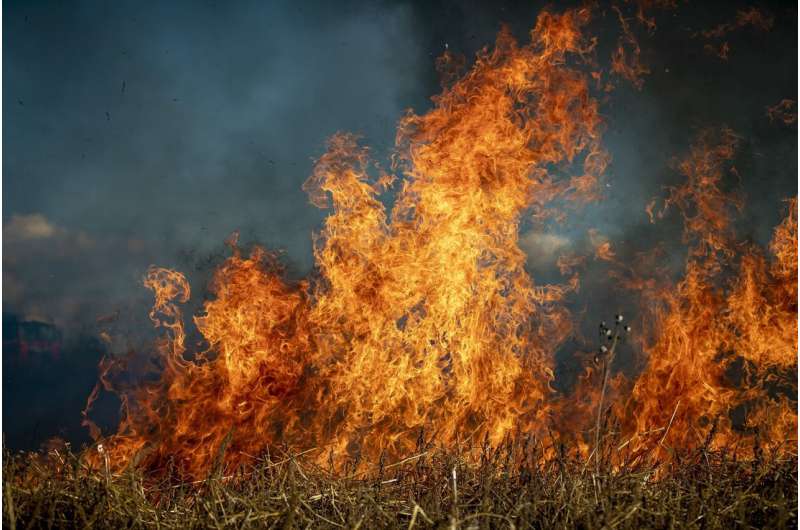This article has been reviewed according to Science X's editorial process and policies. Editors have highlighted the following attributes while ensuring the content's credibility:
fact-checked
trusted source
proofread
By air, rain and land: How microbes return after a wildfire

The disruption brought by wildfires reaches everything that lives in or near a burning field or forest—including microbes. A better understanding of how microbial communities change and grow after a fire could help researchers predict how bacteria and fungi will respond to major environmental changes.
A study published in mSystems suggests that dispersal—through air or rain, for example—plays a major role in microbial succession after a destructive fire.
Researchers at the University of California, Irvine, spent a year tracking how bacterial and fungal communities returned to the leaf litter in a burned field. They found that the emerging microbial communities in the soil surface changed with the seasons and the reappearance of plants, and that the assembly of those communities was largely driven by dispersal.
The risk and extent of big, ecological disturbances like wildfires have been increasing in the last few decades.
"We know with climate change and human activity we're disturbing our ecosystems more and more," said Kristin Barbour, lead author on the new study and a Ph.D. student at the University of California, Irvine. "Microbes, especially those in the surface soil, perform a number of really key ecosystem processes, like carbon and nitrogen cycling." Bacteria and fungi, she said, break down the dead and decaying plant matter on the floor of a field or forest.
Barbour originally set out to study microbial dispersal in the context of droughts, but her plans changed after an unplanned wildfire burned a field site at Loma Ridge, near Irvine. What seemed like a setback became an opportunity. "We wanted to take advantage of this disturbance, especially since wildfire is becoming more frequent in many parts of the world," Barbour said.
The intense heat produced during a wildfire alters the chemical composition of the leaf litter, where microbes reside, and can shift the microbial communities in an ecosystem.
The researchers looked at two ecosystems that had been affected by the fire: a semi-arid grassland and a coastal sage scrub. To study the movement of microbes, they used four configurations of dispersal bags. For the first, they used burned leaf litter to fill small porous pouches that allowed microbes to pass in and out.
For the second, a control group, they sealed leaf litter in bags that did not allow movement in or out. The third configuration was a porous bag filled with glass slides, to collect microbes as they moved through, and the fourth, another control group, included closed bags with glass slides.
At five times during the year after the fire, Barbour and her colleagues collected dispersal bags from both sites and identified bacteria and fungi on the leaf litter. They found that the effect of dispersal differed in the two environments, suggesting that microbial responses are dependent on their environment. "Which hurts our ability to make generalized statements," Barbour said.
They did see some recurring patterns. Overall, dispersal from the air contributed most significantly to the microbes entering the soil surface—34% of the bacteria and 42% of the fungi. They also found that in the first few months after the fire, before plants had re-emerged, bulk soil (the soil beneath the leaf litter) explained the largest share of immigrating bacteria.
The study of how microbes move through the environment is an emerging area of research, Barbour said, but one that's intimately connected to larger issues of how big disturbances change the environment.
"There's a lot of exciting work being done right now, looking at dispersal and at microbial communities out in the environment," she said.
More information: Kristin M. Barbour et al, Testing the contribution of dispersal to microbial succession following a wildfire, mSystems (2023). DOI: 10.1128/msystems.00579-23
Provided by American Society for Microbiology




















